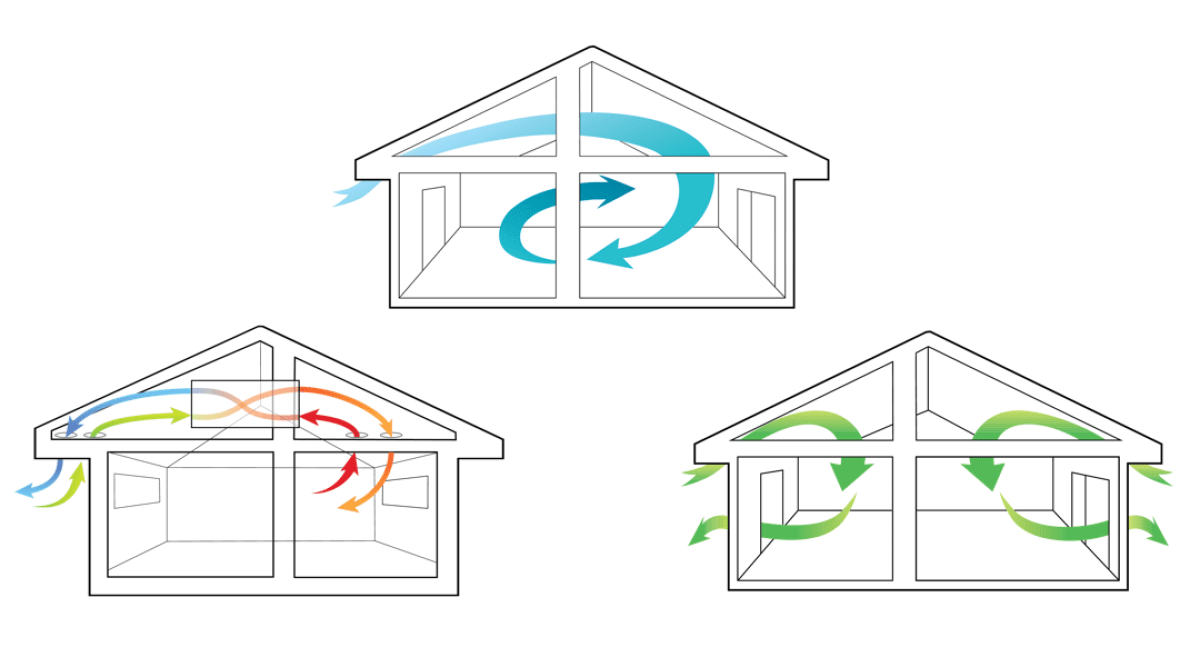Different Types of Ventilation & Their Effectiveness Based on Airtightness

You already know that adequate ventilation keeps indoor air quality at a good level. Ventilation removes air pollutants, regulates temperature and prevents condensation, by extracting stale air and letting fresh outside air flow through.
But did you know the airtightness of a property is key to determining the best ventilation type for that property? As the Building Code gets an update and increases airtightness for more energy-efficient properties, good ventilation becomes even more important.
Here, we compare the different types of ventilation available, and how to choose a ventilation system based on how airtight a property is.

Natural ventilation
Natural ventilation describes a passive flow of air due to natural forces (such as wind and thermal buoyancy). This type of ventilation drives the outside air in through purpose-built openings, like windows, doors and vents.
This type of ventilation generally works well for older, less airtight buildings that have more gaps for stale air to leak out of. For new builds that are more airtight, air movement is restricted and homeowners might need to look for additional ventilation methods. Simply opening a window or door isn’t always a viable option.
Since natural ventilation doesn’t need any mechanical systems, it’s a low-cost and energy-efficient way to ventilate a space.

Mechanical ventilation
Mechanical ventilation uses ducts, fans or other type of mechanical systems to circulate air around a property. It takes away that reliance on cracks, holes and open windows to improve indoor air quality.
This type of ventilation is a must for newer, more airtight buildings. That’s because, while an airtight building is great for thermal comfort and energy efficiency (with air leaks causing around 15-25% of heat loss in buildings), it’s not so good for ventilation. A poorly-ventilated property can lead to a build-up of moisture, mould, bad smells and airborne allergens.
If you’re interested in mechanical ventilation, there are a few options available to you.
Exhaust ventilation
This uses fans to extract stale air from the building and draw in fresh air from outside. It’s a good option for rooms that typically contain high levels of moisture. In New Zealand, all bathrooms and kitchens must have an extractor fan to ensure the building meets healthy homes standards.
Supply ventilation
Working in the opposite direction of exhaust ventilation, supply ventilation uses a fan to push fresh air into the room, increasing the pressure and forcing existing air out.
This is a good option for buildings located in areas with poor air quality, such as those located in busy areas or in areas where airborne allergens, such as pollen, are high. That’s because it offers a good level of control over the incoming air and keeps outdoor irritant levels low.
Balanced ventilation
The final method, balanced ventilation, uses both exhaust and supply fans to balance the air exchange within the building. It’s a popular choice for more airtight homes and buildings that require constant ventilation, such as commercial buildings, where there might be lots of people there around the clock.
Proper airflow helps to eliminate VOCs, mould spores and other contaminants, so balanced ventilation helps keep your family, customers, clients, tenants and employees safe.

Heat recovery ventilation (MVHR)
A top-of-the-line ventilation option, heat recovery systems circulate air while also recovering heat from outgoing stale air and transferring it to the incoming fresh air. Without an MVHR system, this heat would normally be wasted, so your energy bill will probably look a lot healthier, too.
A heat recovery system is generally suitable for airtight buildings that require constant ventilation and efficient heating, and there are a couple of options available:
- Central MVHR systems: Installed in the central heating and cooling system of the building, and circulate air throughout the building using ducts.
- Decentralised MVHR systems: Installed in separate rooms; suitable for retrofitting older buildings.
How should you choose the best ventilation for your building?
Consider the airtightness of your property, along with factors like location, climate, and building use and size, when you’re choosing a ventilation system. SmartVent can help. Book a free visit and our team can advise on the best way to keep your property healthy and your energy efficiency high.